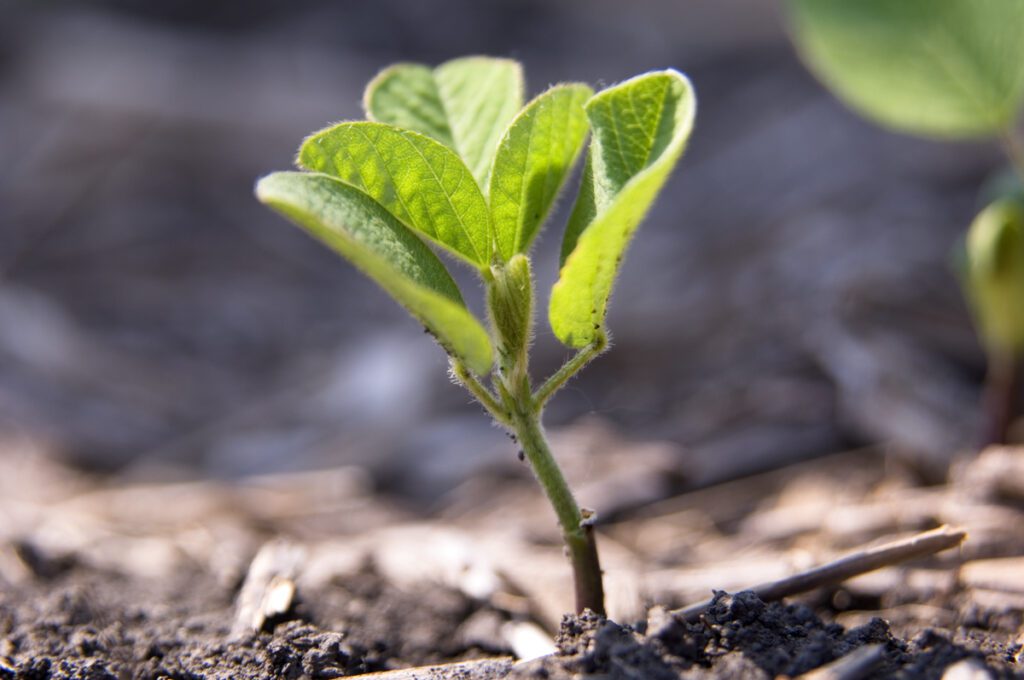Soybean seed rate selection is based on a number of factors

By Shaun Casteel, Purdue Extension Soybean Specialist
Soybean seed rate selection is based on a number of factors such as germination score, seed quality, variety, seed protection, planting equipment, and field conditions. Germination score of 90 percent is fairly standard, but I have already seen a few seed lots that were 80-85 percent. Please be sure to check your seed tags.
Varieties have different growth habits and many companies suggest various seed rates based on vigorous or rank growth habit, shorter heights, less branches, etc. Other seed rate changes can be recommended based on a variety’s disease protection or the lack thereof when a dense canopy of soybean plants can be prone to infection (e.g., white mold, Septoria brown spot, frogeye leaf spot).

Another related factor depends on seed treatments used to protect soybean from seedling diseases like Pythium and/or Phytophthora. Seed rates can often be reduced when a fungicide seed treatment is used to protect young developing seedlings rather than sacrificing seed and seedlings by planting more seeds. Insecticide seed treatment rarely provides return within Indiana, so an estimated $10-$15 seed treatment savings is possible.
The remaining factors of planting equipment and field conditions create sources of variation in seed rate recommendations. My standing agronomic recommendation has been to target 100,000 to 120,000 thousand plants per acre regardless of row width, planting equipment, and field conditions.
Overall target plant population will not change, but the seed rate will change primarily due to planting equipment. Higher seed rates with drills vs. planters. Seed rates should often be increased in tougher field conditions (e.g., cool and wet). I usually reduce seed rates on fields that tend to get rank growth of soybean (e.g., muck, highly manured)
Planting equipment
What is the agronomic optimal seed rate? More than 58 field-scale trials, the 15-inch planter requires fewer seeds than the drill to get comparable stands. The agronomic optimal seed rate for the 15-inch planter was an estimated 140,000 seeds per acre (90 percent germination). Whereas, the drill (7.5-inch and 15-inch rows) was an estimated 175,000 seeds per acre (90 percent germination).

Early season stands averaged 105,000 plants per acre with planters compared to 115,000 plants per acre with the drills. Interestingly, both types of planting equipment ended the season with approximately 85,000 plants per acre by harvest. I do not see much need to alter the seed rate of a planter if your row widths range from 15s, 20s, twins on 30s, etc.
What are the economic optimal seed rates? We used the agronomic yield response curves to create economic optimal seed rates (EOSR) based on a range of seed costs and market prices when using a planter vs. a drill. (See Tables 1 and 2).
For instance, the EOSR for 15-inch planter with seed costs of $60 per 140,000 unit and market price of $10 is 128,354 seeds per acre. If your seed costs went up to $80 per 140,000 unit, then your EOSR would decrease an estimated 5,000 seeds per acre to 123,674 seeds per acre (Table 1).

Please note plant stands will be lower (obvious, but true). Our trials averaged an estimated 75 percent establishment rate for planters, which includes the 90 percent germination score and emergence potential across the field conditions. Therefore, the last EOSR of 123,674 seeds per acre would have a stand near 92,755 plants per acre.
As a point of comparison and adjustment based on planting equipment, the EOSR for drill with seed costs of $60 per 140,000 unit and market price of $10 is 150,956 seed per acre. If your seed costs went up to $80 per 140K unit, then your EOSR would decrease an estimated 7,000 seeds per acre to 143,595 seeds per acre (Table 2). Our trials averaged an estimated 60 percent establishment rate for drills, which includes the 90 percent germination score and emergence potential across the field conditions. Therefore, the last EOSR of 143,595 seeds per acre would have a stand near 86,157 plants per acre.
All of the EOSR will be below the agronomic optimal seed rate since we are looking to optimize profits (i.e., balance of input costs, market price, and yield production). The EOSR will decrease as seed costs increase; whereas, the EOSR will increase as your market price increases.
Please use these tables to adjust your seed rates based on planting equipment, seed costs, and market price. You may need to increase your seed rates if your germination scores are below 90 percent, field conditions are cool and wet, heavy residue, or seed is not treated with fungicide.
Posted: March 21, 2025
Category: Indiana Corn and Soybean Post - March 2025, ISA, News, Purdue University




